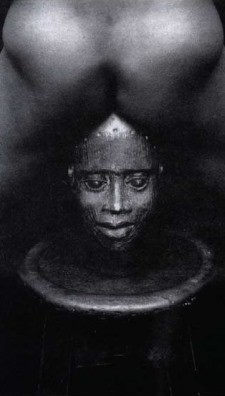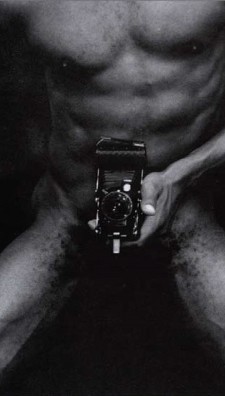Rotimi Fani-Kayode died 29 years ago (21 December 1989), in exile, after moving to England at the age of 12 to escape the Nigerian Civil War. Today, the combination of raw emotion and transgressive physicality in his photographic portraits and compositions, and his exposes the tensions created by sexuality, race and culture, is as relevant as ever. Dele Meiji recalls his encounters with the artists images.
I first encountered Rotimi Fani-Kayode in a photography bookshop on Marchmont Street, in the heart of Bloomsbury. Today there is no sign of it, all trace of it obliterated by the presence of new cafés and boutiques. I was in my early twenties, Yoruba and Nigerian, twice displaced, engaging in my own version of an immigrant experience that has been lived a million times over. It is an experience that, no matter how rich, is always characterised by loneliness and a search, always a search – despite busyness, sadness, or the humdrum of living – for things that signify rootedness, and home. For me, nostalgia, imagination and desire coalesced on that winter evening on Marchmont Street. Entering that bookshop, I met a mask, and a man, that has haunted me ever since.
The mask is the face of a man biting fiercely on a flower sprouting out of a palm leaf, his head adorned with a crown of small, white flowers – dandelions perhaps. Leaves cover his face in a visual echo of mariwo, the palm fronds that cover the entrance to forest shrines in Yorubaland. The mouth and face is aglow with ferocity, but closed in what looks like bliss. The most striking thing for me about the image was the name emblazoned on the book, Rotimi Fani-Kayode.
On that cold evening I had the bookshop to myself, save for the sales assistant. In the confines of the small space I reached up to pull the book down, glancing excitedly through the pages, encountering images of gods and people in poses both sacred and profane. This was a rare visual encounter with the iconography of my ancestors – and the knowledge, if only intuitive, that I had a subject worthy of a biography. Being a poor student at the time, I didn’t buy the book immediately – I recall rushing to my university campus and searching online for any information I could find about him. Perhaps because I was too busy absorbing the images, I don’t recall registering the fact of his death in the bookshop. It was only sitting in front of a computer screen on campus that I remember noting with sadness that he had died in 1989 of AIDS-related illnesses.
I remember my sense of excitement at discovering his existence; it seemed unfair that death should have laid its hands on someone who was evidently meant to be eternal. More so because death had transformed him into an ancestor; here was a hero for me in the same vein as Toni Morrison, James Baldwin, and Bayard Rustin, but one whose own journey connected directly with my sense of displacement and identity as a young, Yoruba, Nigerian at the start of the 21st century.
For those of us born into this period of history, and into the urban spaces of Nigeria, a connection with the myth and symbolism of our ancestors is often hard to find, and barely encouraged. In contrast to the evangelical fervour of my Christian upbringing, I was already fascinated with the religious and social inheritance of the old Yoruba aborisa religion. Viewing Fani-Kayode’s images, I encountered the first exploration of it, by someone of my time and place, that felt relevant and connected to my own world view.
Even for those of us who felt savvy about the richness of our cultural inheritance, there was a notable absence of engagement with Yoruba mythology in our intellectual life. So for me, here stood another “Abami Eda”, similar to Fela, that other, more famous contemporary of Fani-Kayode, who also used his life and art to model the construction of a modern, African identity that embraced continuity with our religious ancestry, rather than a rejection of it. This embracing included a performance of sexuality notably different from the puritanical norms of Victorian interpretation that I, and no doubt many others, inherited from our parents and the founding elites of the Nigerian state. An elite that both Fela and Fani-Kayode were part of, but from which Fani-Kayode found himself estranged, by the fateful quirk of his sexuality. Yet, from this place of estrangement, Fani-Kayode committed his most audacious act – the re-insertion of queerness into Yoruba history and identity.

In “Bronze Head, 1987”, a man’s ass sits on a prototypical Yoruba carved head placed on what looks like a divination board. The Yoruba veneration of the head is illuminated with a corollary but much less spoken about concept – the ass as a source of pleasure and beauty. Simultaneously, the image confirms and implodes conservative ideas of Yoruba culture, and reminds us that within Yoruba religious ideas, the types of desire to which the body responds are very much a product of fate, destiny – something that your ori, your head, as the author of your fate, has determined. In referencing the anus as a site of pleasure, and the continuous engagement with homoerotic themes in his work, Fani-Kayode placed his own identity at the centre of his work and of the Yoruba aesthetic and philosophical horizon. This was, perhaps, the final element of my fascination with him as a subject; for to exist as he did, boldly, openly, defiantly gay in the 1980s of England and Nigeria seemed no small thing.
I was coming of age in the early 2000s, a time when Nigerian culture seemed consumed by a hysterical kind of evangelism and an aversion to any tolerance for difference. That a person like Fani-Kayode once lived seemed unimaginable. So to encounter him in the pages of history led me to wonder, how did he do it? What, as Jimmy Baldwin said, was the price of the ticket? Like all cult figures, a mythos has developed around Fani-Kayode, a mystique that is both enticing and obfuscating.
Since my encounter, Fani-Kayode’s work and legacy have become better known, and rigorously championed by Autograph ABP, the organisation of which he was a co-founder and the first chair. In 2014 an exhibition of his work was held in Cape Town – the first ever exhibition of his work on the continent. Yet, like that bookshop in Marchmont Street, we may be in danger of losing documented memory of him to the mythology that has developed around his life and work. A life such as this, which was fiercely lived, should be better documented.



Hence the “Searching for Rotimi” project. My goal is to publish a biography that explores his life and work and the materiality of his existence – how he lived and breathed in the world. Within this, there is a wider project, of engaging with the range of people, communities and organisations that he knew and encountered. This, I hope, is as much a communal project as a personal one. I would like to hear from people who personally knew Rotimi Fani-Kayode in life, as well as those who knew of him. There has been a long hiatus between my encountering Fani-Kayode’s work and undertaking this project. In recent years, however, I’ve had the privilege of meeting some of the people who knew and worked with him. Already, some of our conversations have thrown new light on the subject, and moved my knowledge, at least, from myth to history. What I hope is that in the next few years I can contribute to the historiography of the times and the cultures through which he lived, and bring back to life a person who was always larger than death.


This story features in the Chronic (April 2016), an edition in which we explore the tensions between reform and revolution, and decolonisation and the neoliberal order in the academy, through the lens of history and via the alternate education paradigms based in indigenous knowledge systems, and also arising from South Africa’s radical anti-apartheid struggle.
To purchase in print or as a PDF head to our online shop. Copies coming to your nearest dealer now-now.
